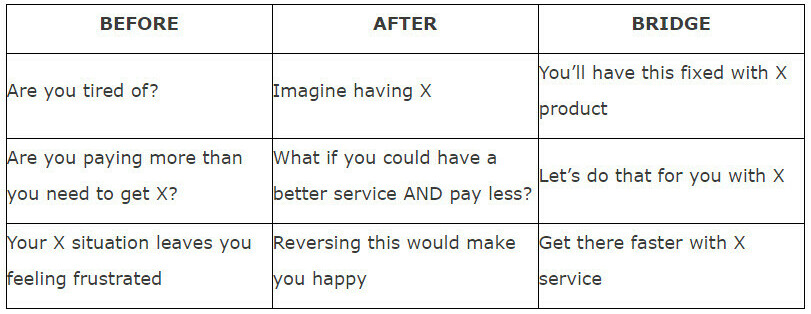Module 3: Conversion-Focused Copywrite Essentials

Learning Objectives
Show your customers their result.
Whatever the reasons people say they buy, they’re all looking for a particular outcome. They’re spending money because they want a result. When you write sales copy, you need to be able to show them what this result will be.
In this module, you’ll practice the key skills of copywriting that sells, and you’ll recognize how third-party comments can strengthen the impact.
Lesson 1: Tap into Their Imagination
Learning Objective
Develop compelling sales copy to help your customers visualize the positive transformation they’ll experience once they purchase your offer.
Help Your Buyers Imagine Their Results
Think about why someone is buying or using your product. Now, think about what your product does for them. If those two aren’t matching up, then you’re not meeting their expectations or wishes.
Your copy should help customers see how they can get from where they are now to where they want to be through buying your offer and experiencing the benefits it promises.
Remember that a benefit isn’t the product or service you sell, it’s the value a customer receives. Vague statements like “best quality” or “best service” don’t have impact. The benefits need to be specific and relevant.
In many places your sales copy will be quite short. In this case, you only have a few words to demonstrate how life will be with your product or service. Use emotions and feelings to increase the impact. Adding images that depict the "after" picture can sometimes achieve more than a paragraph of words.
When you’re writing a long sales page, then you’ll have time to describe in detail the transformation and connect them to the emotional benefits they’ll receive.
Use The Before After Bridge (BAB)
When you think about weight loss products or beauty products, it’s easy to demonstrate the transformative results because you can show "before" and "after" photos.
Luckily, there’s a copywriting formula that can do this for you in words. It’s called the Before After Bridge.
It works for all types of copy, short or long, and can be achieved in a few sentences. It works because it paints the picture for your customer of what outcomes will occur when they purchase your product or service.
Before:
This is the situation causing your customers’ challenge. Help them connect to it by tapping into the existing negative situations and the associated negative emotions. For example:
You’re a working mom so busy in your business that you don’t have enough time to play with your kids. You feel guilty, like you’re a "bad mother", and sad you’re missing out on their childhood.
Review the language you identified earlier that customers are using and the challenges and pain points you noted. Use that same language in your "before" description.
After:
This is the situation your customers want. Help them imagine what life would be like in that "different world" by using a positive, descriptive narrative.
Your business is successful and can run without you so you can take time off when you want to spend it with your family. You’ll enjoy all those precious childhood moments and build memories that will last forever. You’ll feel fulfilled as a mother, knowing you’re doing the best you can for your kids.
You paint a picture of the realization of their dream, which is the opposite of their current negative feelings. Use the words and phrases you gathered in your earlier research that speak to your customers’ goals.
Bridge:
The bridge is the link your audience is missing to get them from "before" to "after". Connect the two sections by introducing your product/service.
The bridge demonstrates how your product or service solves their problem and leads to the outcomes they’ve dreamed of, and which will be theirs after they’ve purchased.
Here’s an example of Before After Bridge copy:
Before:
You work all hours in your business because you don’t have enough to pay the bills. You’re exhausted, disappointed, and fed up because you can’t make it happen. You missed yet another family birthday because you had to work late.
After:
How would it feel if you could work fewer hours and have more money coming in? Can you imagine yourself lighting the candles on your child’s next birthday cake without worrying about the work you still have to do? Wouldn’t you like to be at all your special family moments?
Bridge:
Take the financial strain away and enjoy all time off you want, by signing up for The Financial Freedom Program. You’ll learn how to tap into your existing assets to build a passive income strategy and enjoy knowing your finances are taken care of.
How to Build The BAB
Here are some ideas for drafting the BAB:

Action Steps:
- Revisit the core message you drafted earlier. Recap on the 3 benefits you offer that deliver this core message.
- Take your chosen piece of copy and paint a picture of the transformation you’re promising by describing:
- The Before
- The After
- The Bridge citing your key benefit(s)
Lesson 2: Let Others Speak for You
Learning Objective
Employ third-party comments to strengthen the impact of your copy so that your prospects feel confident they’re buying the right solution for them.
What Others Say
Even if you won’t say it out loud, we care about what other people think and we take notice of what they say.
That’s why most consumers do their own research on the Internet before they make a purchase. They want to see what past purchasers have said.
People usually look at online reviews or ratings from those who’ve already bought your product or service. They trust that these comments give the real, unvarnished truth about a product, and they’ll be influenced to purchase (or not purchase) based on what they read.
The impact of third-party reviews is significant because these comments are seen as unbiased, rather than your own copy which is judged as anything but neutral.
The transformation picture you’ve painted in your copy may be compelling, but it will be even more effective when painted by another customer. It will help them find out what the purchase did for actual buyers. This will help them visualize their own life after buying and will reinforce the picture you’ve painted for them in the BAB process.
How to Use Third Party Copy
Rather than wait for followers to post haphazard comments, proactively collect them yourself.

Testimonials
You probably already use testimonials and positive comments to provide social proof. By putting them inside your sales copy, you can use them to strengthen your message. This could be a quote from a short sentence in an email or social media post, or a longer testimonial or complete case study on a sales page.
Thinking of the end copy will help you when you ask for testimonials. You want a demonstration of the before and after picture, so ask for it. It’s like a mini case study which will show tangible benefits for real-live humans.
For example, here’s a template you can use to give you that:
I worked with X on her XX program. When I started, I was X but by the end of the course I had XXXX.
Keep in mind your key marketing message too, so if the main benefit your customers are seeking is to save time:
I bought the XX power grinder on Saturday and had my work finished by Sunday! I can’t believe it took so little time to do X for my kid’s room. I am truly a proud dad thanks to X.
Reviews and Ratings
Customers are increasingly asked to give an opinion on their experience with a business.
They’re asked to rate all sorts of interactions, from an online page to a customer support phone call. And consumers regularly consult these comments before making a purchase.
Be proactive in collecting reviews. For example:

Collect Reviews
- Always ask buyers to leave feedback. Remember, people are busy and may need a gentle reminder if they don’t act immediately.
- Introduce a feedback process to your web pages and collect your own ratings.
- Use industry sites appropriate to your business such as Amazon, Yelp, and TripAdvisor where customers frequently leave comments.
Anticipate Objections with FAQs
One thing you can be sure would-be buyers will bring up are objections, especially if they’ve seen a comment or low review on a third-party site.
It’s best to handle these head-on. And you can do this effectively through a list of FAQs which you add to your long-form copy. Place it with a clickable link either at the bottom of your sales page or on a separate page.
FAQs can also be a great way to highlight the features and benefits of your product or service. By providing potential customers with answers to their most common questions, you can help them see the value in what you’re offering and make the decision to buy from you.
Action Steps:
- Gather testimonials you’ve received in the past.
- Decide how to integrate them into your chosen piece of copy.
- Pick one specific way to collect reviews (e.g., use a testimonial template, use an online feedback form, sign up to an online review site).
- List all objections for your offer. Turn them into Frequently Asked Questions (FAQs) to supplement your chosen piece of copy.
Lesson 3: Make Your Words Accessible
Learning Objective
Choose writing and formatting that will make your copy quick to read and easily accessible
Your Customers’ Language
Copy means words. The words you choose and the way you present them can make all the difference to a potential buyer.
Let’s recap on the importance of employing the language your audience uses so that your text speaks to your target market:

Start a Conversation with Your Customer
- Match the language you use to the language they use. You identified words your audience uses earlier. Make sure you include these key words and phrases in your copy.
- Focus on a real person, i.e. the customer persona you identified earlier
- Write copy that's conversational and flows as if you're talking directly to that person
Scannable Text
However long you spend perfecting your text, it’s unrealistic to expect visitors to read it in its entirety.
The modern digital reader is looking for scannable text, so you need to become adept at writing it. You only have a small window to grab their attention and motivate them to read on.
What is Scannable Content?
You’re aiming to create visually appealing text that can be quickly scanned to pick up the main points
Here’s a list of the principal components of scannable text:

Always Apply These Principals
- Short sentences (max 3-4 in a paragraph)
- Brief paragraphs (one idea per paragraph)
- Bullet points
- Clear headlines/sub-headings
- Formatting to highlight key points (e.g., bold, italicized, underlined)
- Plenty of whitespace and spaced lines
Have a look at the text in the box below. Are you tempted to read it?
Buyers do their own research on the Internet before they make a purchase. They will certainly look at what online reviews or ratings you’ve had from those who’ve already bought your product or service. They’ll trust these comments rather than your own to give the real, unvarnished truth about a product. The impact on your prospects will be greater because their comments will be seen as unbiased. Your transformation picture may be compelling, but it will be even more effective when painted by another customer. It will help them find out what the purchase did for actual buyers. This will help them visualize their own life after buying and will reinforce the picture you’ve painted for them in the BAB process. How to Use Third Party Copy. Before you can use these comments, you have to collect them. Thinking with the end copy in mind will help you when you ask for testimonials. You want a demonstration of the before and after picture, so ask for it. It’s like a mini case study which will show tangible benefits for real-live humans.
You probably couldn’t be bothered to read it in its entirety, even though it was useful to you. Your customers will feel the same if you deliver large blocks of text like this.
Always make your copy scannable and flowing logically so people can absorb it quickly.
Layouts for Different Channels
You’ve seen that there are many places where people can be directed to your sales copy.
The channel that you use dictates the format and length of the copy. For example, a short product description on an eCommerce store or a short social media post won’t have the detail of a long sales page.
Where you have limited space, choose your words very carefully and don't waste them.
Stick to your main message and create impact from the start. You might add visuals like graphics, images, graphs, or photos to convey more with fewer words and save you space.
Let’s look at a few different layouts:

SMS
The text for an SMS is probably the shortest piece of copy you can create as it’s limited to 160 characters. You need permission to market to someone in this way just like for email, but text messages are opened much more often than emails. This means they’re good for personalized exclusive offers and other promotions with a short clickable link to the cart.
Your layout could look like this:

SMS Layout
- Greeting (optional)
- Message
- CTA
- Short URL
Here are a couple of examples:
Dear Joan, We’re offering exclusive access to our marketing course to friends like you. Sign up to CourseLink by Friday shorturl.at/bknOS
Hi Laura, Good news! The sofa you asked about is back in stock in the color you want. I’ve set it aside in your cart. Order by Friday https://sleepcushy.com/
Sales Posts for Social Media
If you’re creating short copy, for example for a direct message or social media post linked to a sales cart, you’ll be using more words and your layout will look like this:

Social Media Layout
- Headline
- Text
- CTA
Example:
Looking for a tasty treat?
Get your fave XBrand cookies at [URL link] and make some memories at home with this simple sweet recipe. A treat for you and your loved ones.
Visuals will boost the impact of such a message.
Sales Emails
Sales emails will be wordier with more steps for example:

Email Layout
- Subject line
- Personal greeting
- Opening line
- Text
- CTA
- Personal signoff
- P.S.
Sales Pages
These will be the longest with this type of format:

Sales Page Layout
- Headline (and subheadings)
- Introduction
- Offer
- Price
- Testimonials
- CTA
- FAQs
Action Steps
- Create scannable text for your chosen piece (e.g., add bullets, increase white space).
- Draft the layout for your chosen piece of copy. Make sure it’s appropriate for where it will be placed.










